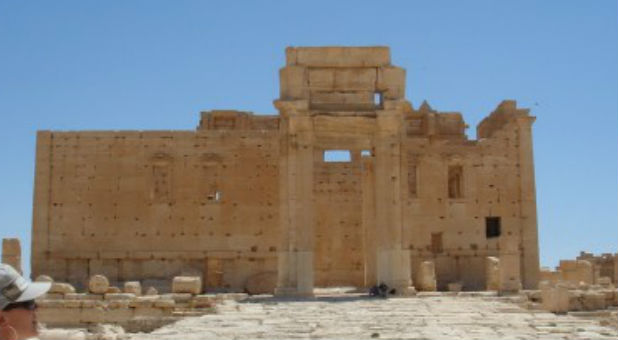If you tried to put up a large cross in a public park in New York City, there would be lawsuits flying all over the place, but apparently an ancient pagan arch that served as a gateway to the Temple of Baal is no problem at all. On Monday, Sept. 19, a reconstructed version of Palmyra’s Arch Of Triumph (also known as the Monumental Arch) will be erected in New York City. Specifically, it will be located in City Hall Park in Manhattan. The organization behind this project is known as the Institute for Digital Archaeology, and they have confirmed the location and the date on their official website.
This arch was originally constructed in Palmyra, Syria by the Roman Emperor Septimius Severus in the third century A.D., and it stood there until it was destroyed by ISIS in 2015. The following comes from the Wikipedia article about this arch.
The Monumental Arch, also called the Arch of Triumph (Arabic: قوس النصر) or the Arch of Septimius Severus, was a Roman ornamental archway in Palmyra, Syria. It was built in the 3rd century during the reign of emperor Septimius Severus. Its ruins later became one of the main attractions of Palmyra, until it was destroyed by the Islamic State of Iraq and the Levant in October 2015. Most of its stonework still survives and there are plans to rebuild it using anastylosis.
On this map you can see how Palmyra was laid out. The Arch of Triumph (identified on the map as the “monumental arch”) connected the main street of the Colonnade with the Temple of Bel. If you wanted to go to the Temple of Bel, there was essentially one way in and one way out, and everyone coming and going would pass through this arch.
Those that are familiar with ancient Middle Eastern deities already know that “Bel” and the “Baal” that we find in the Bible were one and the same. Here is more from Wikipedia.
Bel (/ˈbeɪl/; from Akkadian bēlu), signifying “lord” or “master”, is a title rather than a genuine name, applied to various gods in the Mesopotamian religion of Akkad, Assyria and Babylonia. The feminine form is Belit ‘Lady, Mistress’. Bel is represented in Greek as Belos and in Latin as Belus. Linguistically Bel is an East Semitic form cognate with Northwest Semitic Baal with the same meaning.
Back in April, the arch that stood directly in front of the Temple of Baal was supposed to be put up in Times Square, but fortunately that project was ultimately canceled. A reproduction of the Arch of Triumph (the arch discussed in this article) was put up in Trafalgar Square in London at that time, and there were rumblings that a reproduction of the Arch of Triumph would also come to New York at a later date.
Unfortunately, that has now become a reality.
So why are people getting so upset about some ancient arch that may be connected to an ancient god that nobody seems to worship anymore?
Well, the truth is that “Baal” is mentioned in the Bible more than 100 times. A very high percentage of current world religions can be traced directly back to this ancient deity and to ancient Babylon, and the practices involved in ancient Baal worship are “eerily similar” to things that go on in society today. The following comes from an excellent article by Matt Barber:
Ritualistic Baal worship, in sum, looked a little like this: Adults would gather around the altar of Baal. Infants would then be burned alive as a sacrificial offering to the deity. Amid horrific screams and the stench of charred human flesh, congregants – men and women alike – would engage in bisexual orgies. The ritual of convenience was intended to produce economic prosperity by prompting Baal to bring rain for the fertility of “mother earth.”
The natural consequences of such behavior – pregnancy and childbirth – and the associated financial burdens of “unplanned parenthood” were easily offset. One could either choose to engage in homosexual conduct or – with child sacrifice available on demand – could simply take part in another fertility ceremony to “terminate” the unwanted child.
Modern liberalism deviates little from its ancient predecessor. While its macabre rituals have been sanitized with flowery and euphemistic terms of art, its core tenets and practices remain eerily similar.
We tend to think that we are vastly more “advanced” than the pagan idol worshippers of the ancient world, but is that really the case?
They killed their babies by the thousands, but we have killed our babies by the millions.
They had “free love” around the altars of Baal, but we have turned it into a permanent lifestyle.
Multitudes would gather around the altars of Baal to watch the bisexual orgies, but we have turned watching others having sex into a multi-billion dollar industry.
Just like ancient Israel, our society has turned away from following the God that created all things, and instead we are embracing the ways of the ancient pagan world. Unfortunately, there are very serious consequences for doing this.
I believe that it is quite appropriate that an arch that once served as a gateway to the Temple of Baal is going up in New York City on Monday, because we are going down the exact same path that ancient Israel once did.
Sadly, if we keep doing the same things that they once did, our ultimate fate will end up being very similar as well.
See an error in this article?
To contact us or to submit an article





















